evolution 🙊
1/58
There's no tags or description
Looks like no tags are added yet.
Name | Mastery | Learn | Test | Matching | Spaced |
|---|
No study sessions yet.
59 Terms
1. every species produces more offspring than can survive due to limited resources
2. overproduction leads to competition between the members of a species for the limited resources
3. there is an inherited variation among the members of a species (caused by genetic differences)
4. individuals who are poorly adapted to their environments are unlikely to survive long enough to produce offspring
1. what happens to well adapted individuals?
2. what happens to the poorly adapted individuals?
3. what is this process also known as?
1. they survive long enough to reproduce, passing on the favourable traits, which can eventually, over many years cause major changes in the traits of species
2. they die before they are able to reproduce, preventing the poorly adapted genes from passing on
3. natural selection
a) a branching point
b) the y axis
c) the top
d) the bottom
e) each line
b) time
c) present
d) past
e) a species
what are the three main steps of a speciation event? (3)
geographical isolation, divergence, reproductive isolation
how does a speciation event occur? (4)
members of a species can mate with each other to produce fertile offspring
geographical isolation occurs, the species is separated into two separate populations
over many generations, the 2 different populations become increasingly different from one another as they evolve to their environments (divergence)
reproductive isolation occurs, meaning that the two groups can no longer mate and produce fertile offspring
a) how geographical isolation could occur
b) divergence
c) the hard parts of fossils that don’t decay (3)
d) types of sediment (2)
e) types of sedimentary rock (3)
b) each population evolves to camouflage better in their environments
c) bone, shell, teeth
d) sand, silt
e) limestone, sandstone, shale
what is fossilisation?
the process by which the minerals in water replace the minerals in bone
1. an animal dies and falls to the bottom of a lake or ocean
2. soft parts of the animal decay, leaving the hard parts
3. a layer of sediment covers the hard part of the organism
4. over 1000s of years, sediment builds up. the minerals in the bone are replaced with the minerals in the water. pressure from the upper sediment layers compresses the lower layers into sed. rock
5. the land is lifted by tectonic plate movement, and a river erodes the sed. rock to reveal the fossil
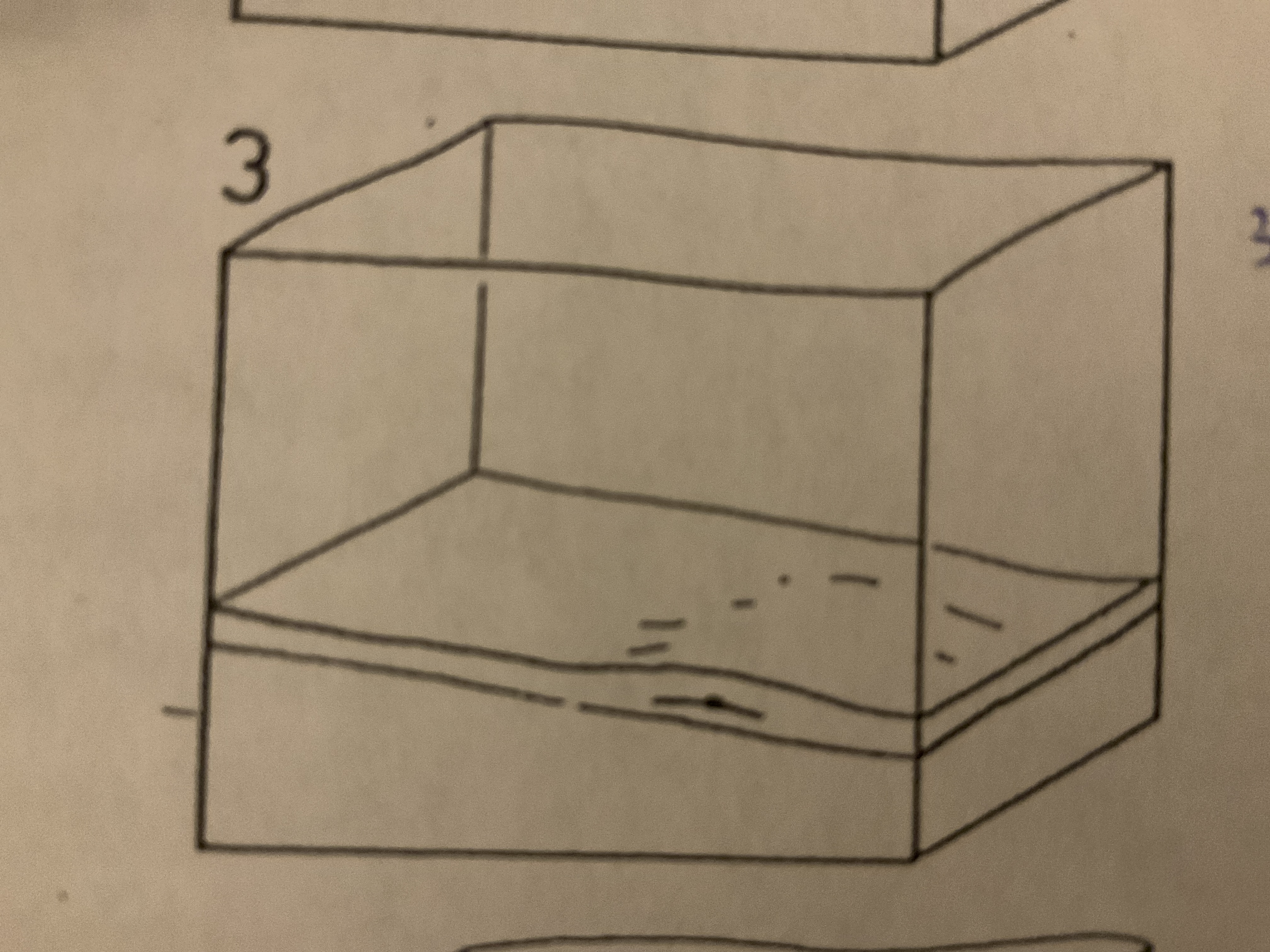
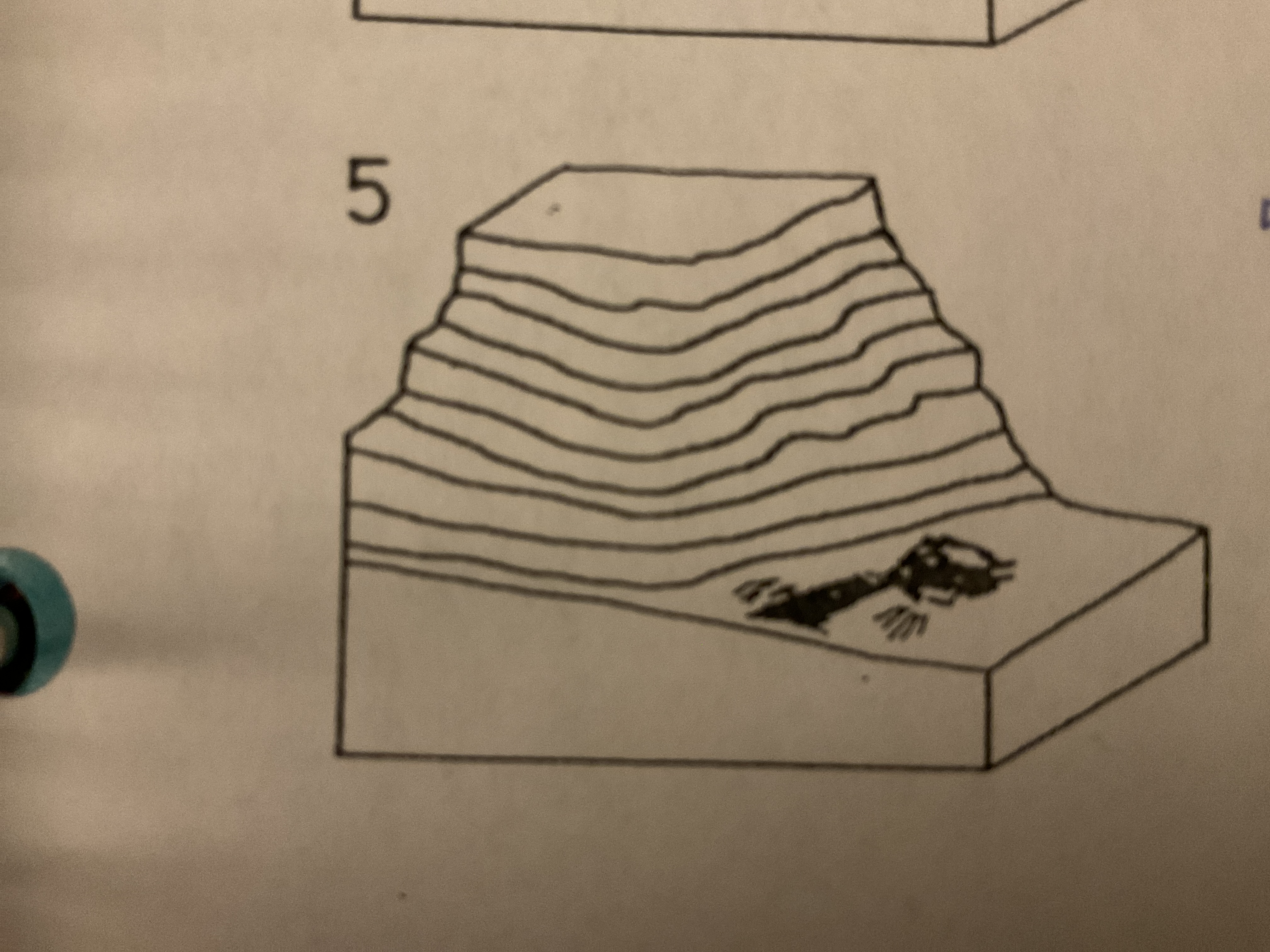
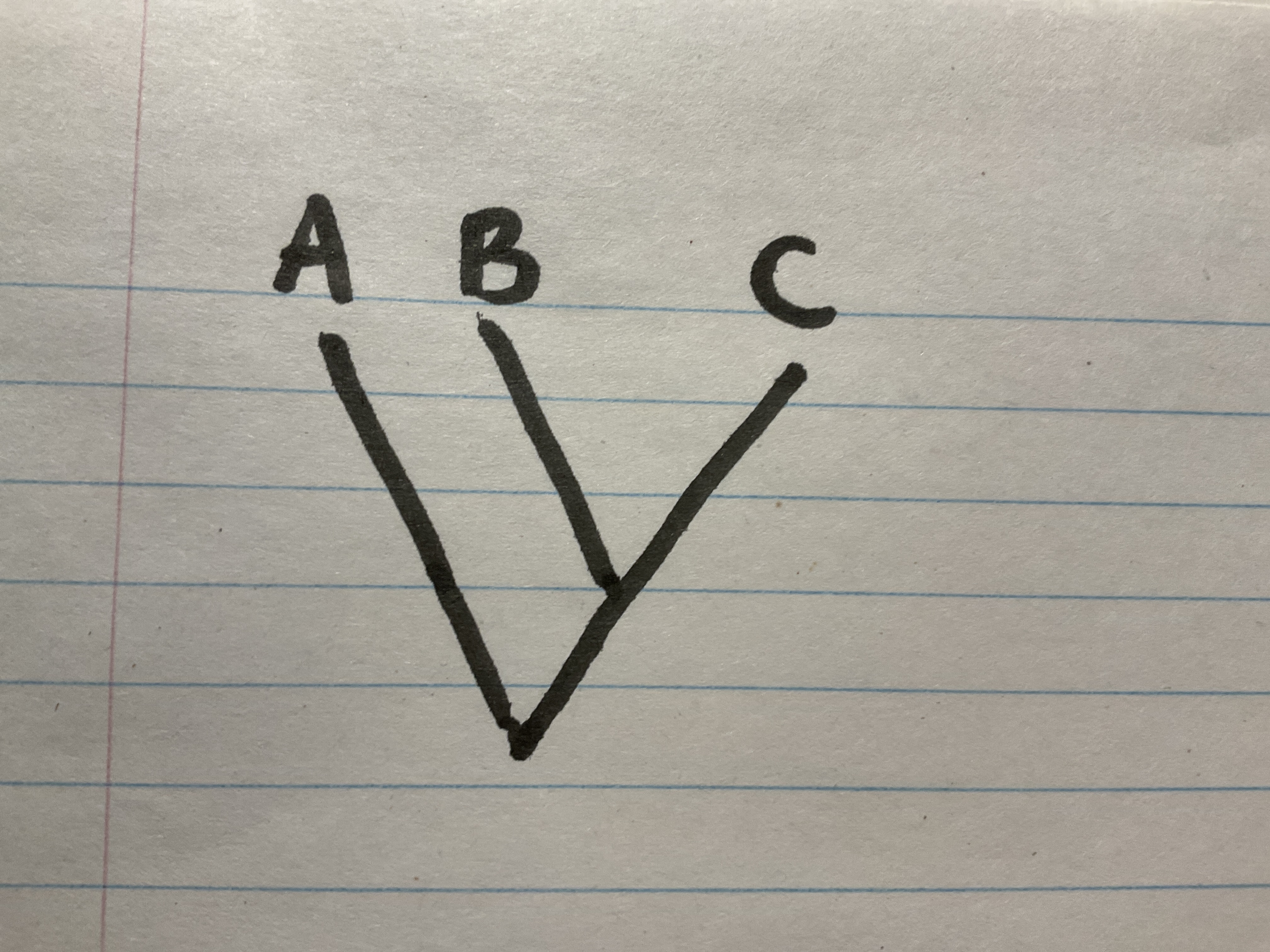
which are these two species are more closely related and why?
B and C, because they have the most recent common ancestor
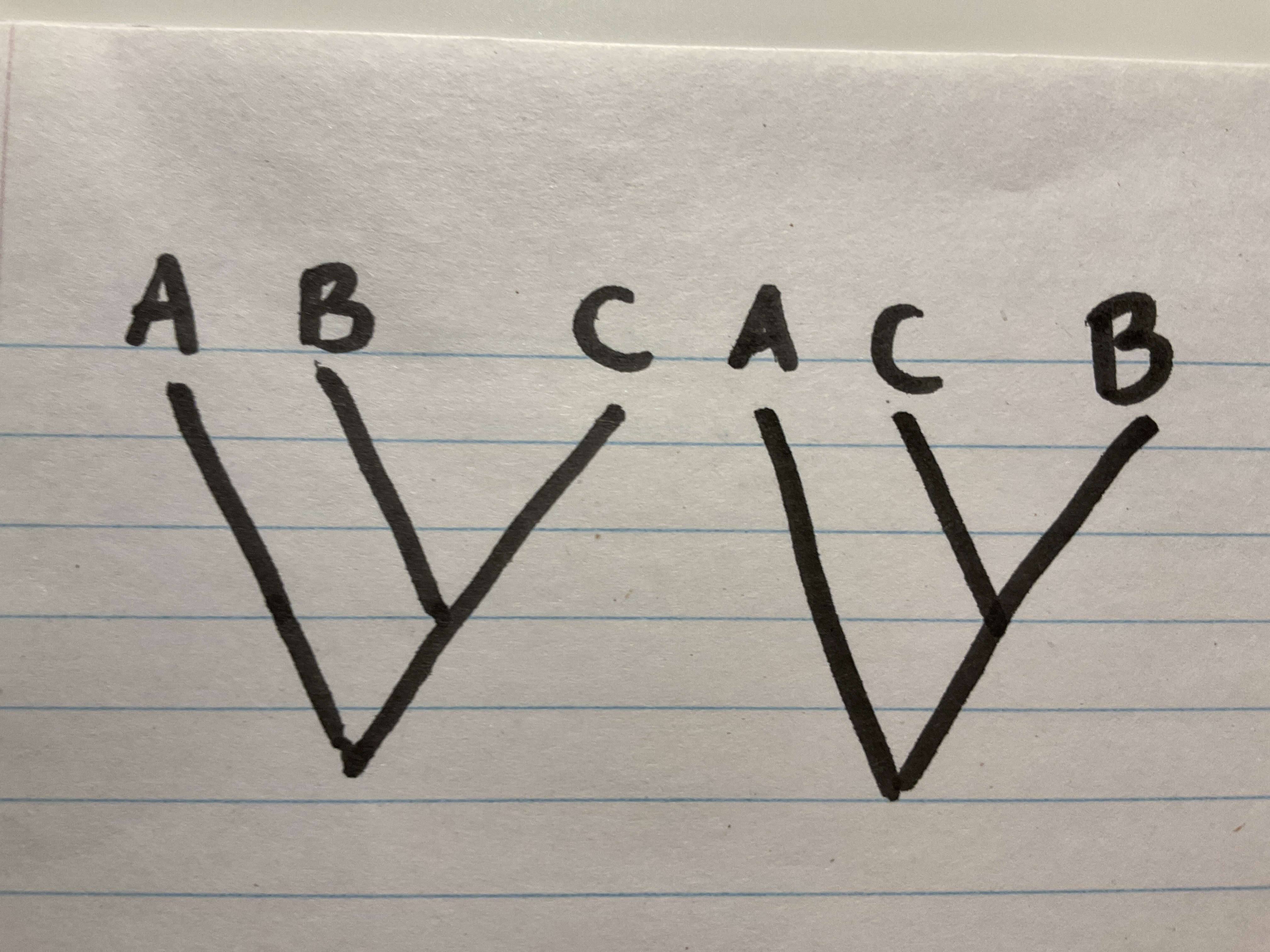
are these phylogenetic trees different or the same?
the same
all life on earth is _. therefore, all _ can be placed on a _ tree. (3)
related, species, phylogenetic tree
how can you figure out if species are related to each other?
by comparing which physical traits they share
how many species of _ are there?
a) mosses
b) conifers
c) flowering plants
d) ferns
a) ~12000
b) ~600
c) ~300000
d) ~10000
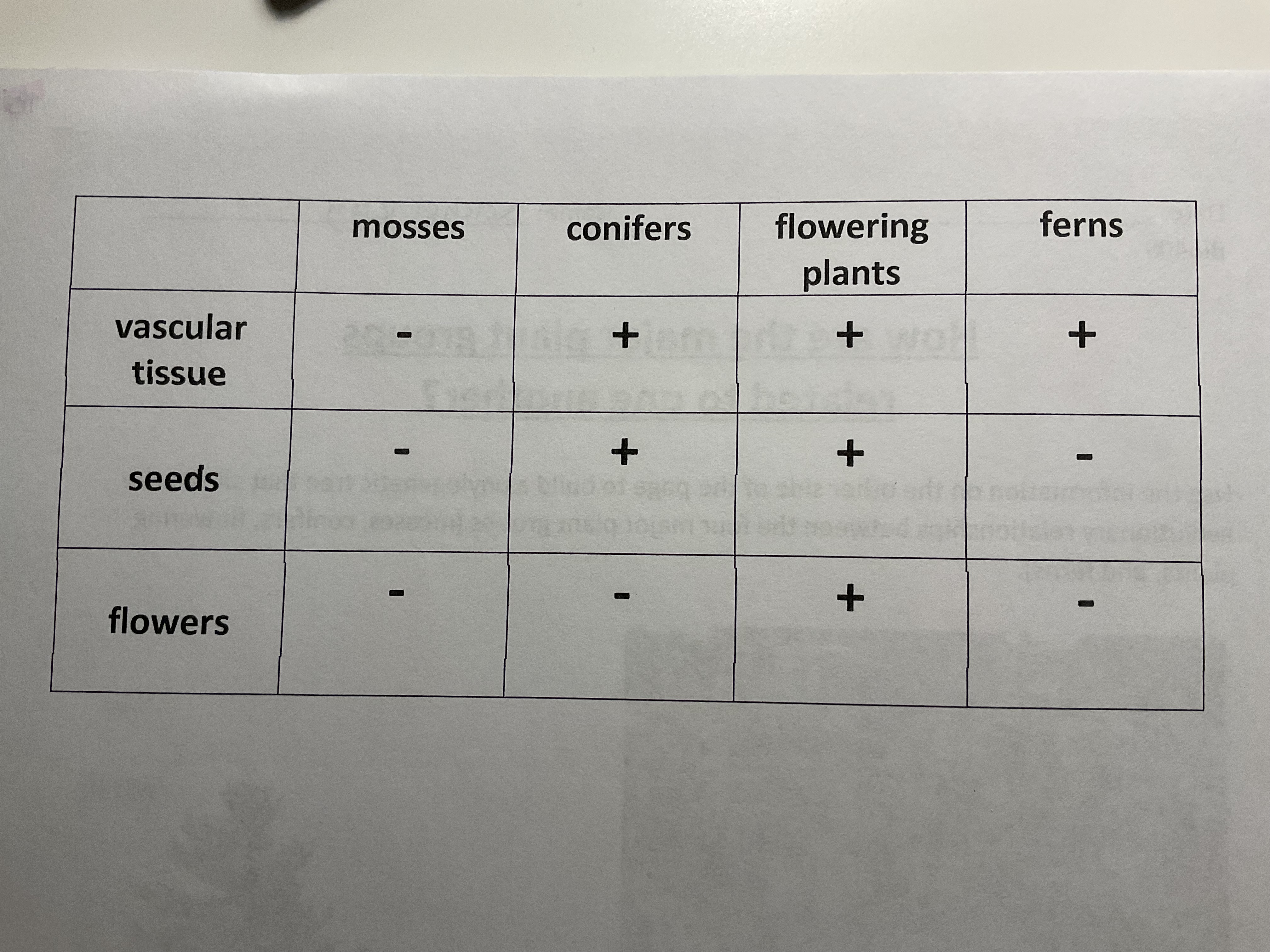
draw a phylogenetic tree based on this chart
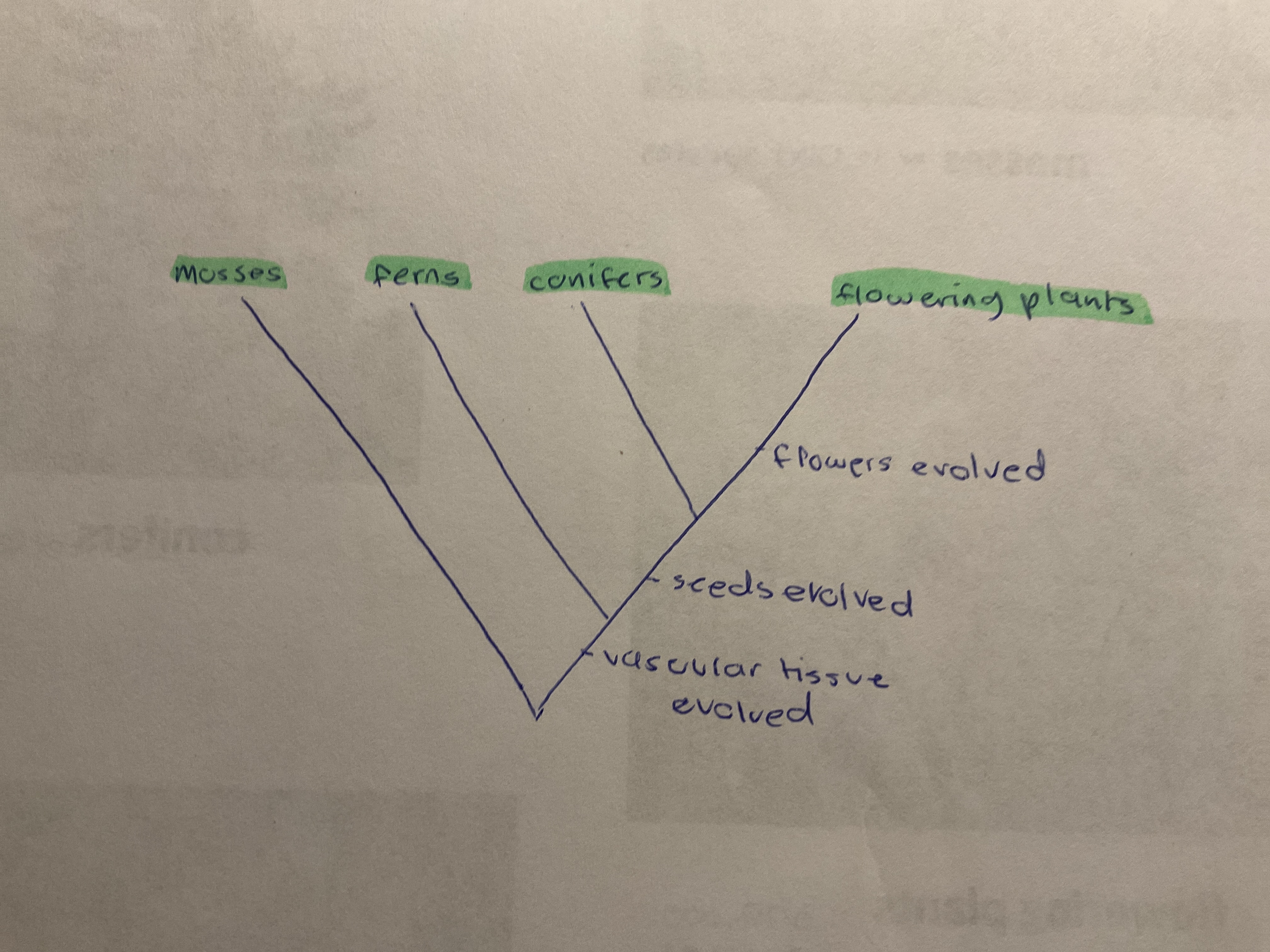
what are some of the organisms darwin noticed in the galapagos? (3)
blue footed boobies, long necked giant tortoises and marine iguanas
what are some characteristics evolved by the iguanas that help them in their environment? (3)
feed on algae in the ocean, partially webbed feet and flat tail
what is one of darwin’s most important contributions?
the scientific explanation for the ways organisms are suited to their environment
which two major factors caused humanity to believe that species were perfect and unchanging? (2)
the book of genesis, the views of the greek philosopher aristotle
how..?
a) old was the earth believed to be before significant scientific advancements were made?
b) is the long necked giant tortoise referred to in spanish?
c) did darwin spend his time as a young boy (4)
a) 6000 years old
b) galapagos
c) reading nature books, fishing, hunting, collecting insects
what did the study of fossils in the mid 1700s reveal?
fossils that differed from the living organisms at the time
what was jean baptiste lamarck’s theory of evolution and why was it wrong?
lamarck correctly believed that fossils evolved into the living organisms he knew, but incorrectly assumed that it was due to an organism intentionally changing its traits and passing on the changed gene
what is jean baptiste lamarck’s theory known as?
inheritance of acquired characteristics
charles darwin:
a) was born in what year
b) was uninterested in medicine because
c) attended which university
d) intended to become
e) sailed on the HMS beagle for how many years
f) spent time on the galapagos islands, found in which ocean?
a) 1809
b) he found it boring, and found surgery horrifying
c) cambridge university
d) a clergyman
e) 5
f) the pacific ocean
after graduation, darwin’s _ professor referred him to the captain of the _.
botany, HMS beagle
what was the purpose of the HMS beagle’s voyage?
to chart the little known south american coast
darwin departed on the HMS beagle in _ at the age of _
december 1831, 22
how did darwin spend his time while the crew were mapping?
he spent time onshore, collecting many different organisms and fossils
which important observations did darwin make while onshore? (3)
the unique adaptations of organisms in different remote places
that fossils found in south america were more similar to the current organisms in south america than fossils in other continents
species on different galapagos islands and mainland were similar but not the same to each other
how did charles lyell’s principles of geology influence darwin?
a combination of witnessing and earthquake and lyell’s book helped darwin to realize that natural forces had and continued to change the earth’s surface
what caused marine snail fossils to be found on the mountaintops in the andes?
earthquakes
what did darwin do once he returned to great britain?
darwin analyzed and discussed his collections, and by the early 1840s, he had produced a long essay describing the theory of evolution which he decided to delay publishing it due to fear of society’s reaction
who was alfred wallace?
a british naturalist who compiled a theory of evolution in the 1850s that was nearly identical to darwin’s
how was darwin’s work eventually published?
- colleagues of darwin presented wallace and darwin’s work to the scientific community
when was..?
a) darwin’s essay presented to the scientific community?
b) on the origin of species by means of natural selection published?
a) 1858
b) 1859
explain “descent with modifications” (2)
- darwin’s theory that present day species arose from a succession of ancestors
- as the descendants spread over millions of years, they began to adapt to their specific ways of life
who wrote on the origin of species?
charles darwin
what is artificial selection? provide an example
a process used by humans to modify species by selecting and breeding individuals to produce certain traits. for example, animals bred as livestock are extremely different from their wild ancestors.
what two observations did darwin make about a process similar to aritificial selection in nature? what conclusions did he draw from this? (4)
observations
the members of a population have variations in traits, and most traits are inherited
all species are able to produce more offspring than can be supported by the environment
conclusions
well adapted individuals tend to produce more offspring than other individuals
this causes favourable traits to accumulate in a population
who was thomas malthus?
when did he publish his essay?
what conclusion did he come to in his essay?
provide 3 examples of human suffering
an economist who wrote an essay on human population
1798
much of human suffering was a result of population increasing faster than the environment could handle
famine, war and disease
what is the difference between natural selection and artificial selection?
artificial selection entails humans choosing desirable traits by breeding organisms that possess them. natural selection is similar, however the environment “chooses” the traits best suited for survival, and the well adapted individuals survive long enough to reproduce
what is the essence of natural selection?
unequal reproduction
what are the 3 key points of evolution by natural selection? (3)
individuals do not evolve in one lifetime
only heritable traits are affected by natural selection
evolution is not goal directed (does not lead to perfect organisms), and natural selection results from conditions of specific areas at specific times
what is extinction? what can lead to extinction?
the loss of a species, major environmental changes
a) which scientists worked with birds in the galápagos Islands?
b) over how long did their research span?
c) which birds did they study?
d) what did they discover?
a) peter and rosemary grant
b) 20 years
c) finches
d) during dry years, the birds with larger beaks did better, during wet years, birds with smaller beaks did better (aka natural selection)
which historical figure(s)…?
a) wrote on the origin of species
b) had the theory “inheritance of acquired characteristics”
c) came to the same conclusions as darwin in the 1850s
d) wrote principles of geology
e) wrote an essay about human population in 1798
f) researched finches in the galapagos
a) charles darwin
b) jean baptiste lamarck
c) alfred wallace
d) charles lyell
e) thomas malthus
f) rosemary and peter grant
how does natural selection render some pesticides useless?
each new pesticide introduced kills most, but not all of its targets, some of which have genetic resistance. the rest of the species is killed, and the only insects producing offspring are immune to the pesticide, rendering it useless as more and more insects are born resistant
what 3 points can we learn about natural selection based on the example of bugs and pesticide?
natural selection is an editing process, not a creative mechanism
natural selection is dependant on time and place
significant evolutionary change can occur over a short time
what are vestigial structures? (+1 example)
a structure found in a modern species that has no function, hind leg bones in a whale
how do vestigial structures come to be?
the structure had a function when it first evolved however the function was lost through evolution
define selection
process by which traits are selected for or against and become more abundant
1. what are the criteria for:
a) natural selection (3)
b) artificial selection (2)
2. why is the 3rd part of the criteria so important?
1.
a) variation in population, traits must be heritable, environment limits population
b) variation in population, traits must be heritable
2. if the environment is not limiting population (and therefore causing adaptation), then something else must (humans)